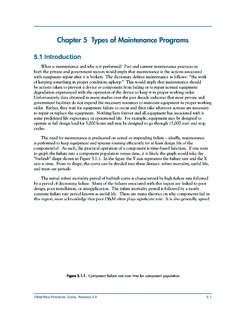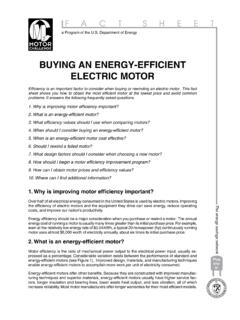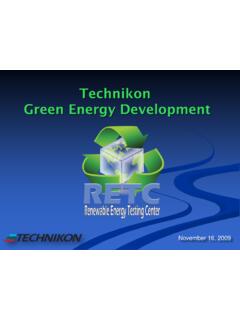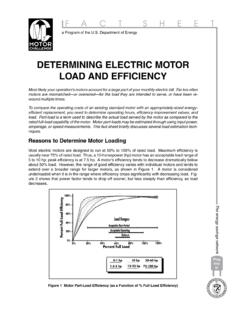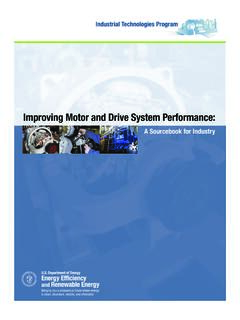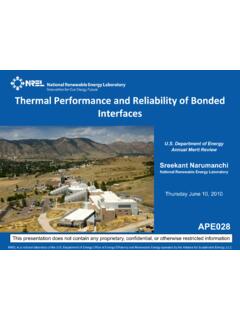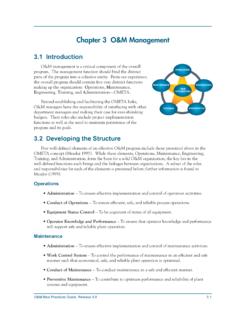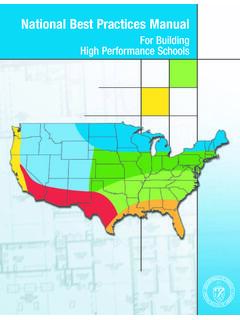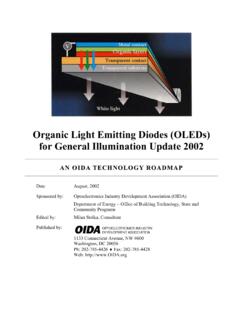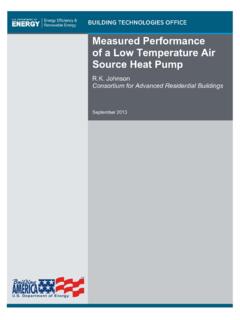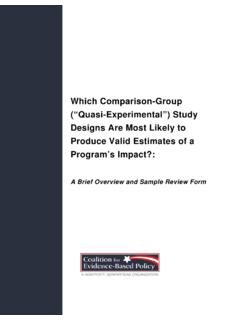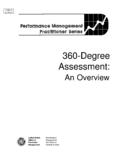Transcription of Overview of Evaluation Methods for R&D Programs
1 Overview of Evaluation Methods for R&D Programs Overview of Evaluation Methods for R&D Programs A Directory of Evaluation Methods Relevant to Technology Development Programs Prepared for Department of Energy Office of Energy Efficiency and Renewable Energy March 2007 by Rosalie Ruegg, TIA Consulting, Inc. Gretchen Jordan, Sandia National Laboratories Overview of Evaluation Methods for R&D Programs Overview of Evaluation Methods for R&D Programs Acknowledgements This booklet introducing managers to a variety of Methods for evaluating research and development (R&D) Programs was completed for the Department of Energy (DOE) by Sandia National Laboratories, Albuquerque, New Mexico, USA under Contract DE-AC04 94AL8500. Sandia is operated by Sandia Corporation, a subsidiary of Lockheed Martin Corporation. Jeff Dowd of DOE s Office of Energy Efficiency and Renewable Energy (EERE), Office of Planning, Budget and Analysis (OPBA) directed the work.
2 Rosalie Ruegg of TIA Consulting, Inc. was principal author and she was assisted by Gretchen Jordan of Sandia National Laboratories. Joe Roop of Pacific Northwest National Laboratories contributed the section on tracking commercialization of technologies. EERE OPBA also acknowledges the guidance of Sam Baldwin, EERE Chief Technology Officer in the production of this booklet. OPBA also thanks Yaw Agyeman of TMS Inc. for his review of the booklet and assistance in preparing it for publication. Notice This document was prepared as an account of work sponsored by an agency of the United States government. Neither the United States government nor any agency thereof, nor any of their employees, makes any warranty, express or implied, or assumes any legal liability or responsibility for the accuracy, completeness, or usefulness of any information, apparatus, product, or process disclosed, or represents that its use would not infringe privately owned rights.
3 Reference herein to any specific commercial product, process, or service by trade name, trademark, manufacturer, or otherwise does not necessarily constitute or imply its endorsement, recommendation, or favoring by the United States government or any agency thereof. The views and opinions of authors expressed herein do not necessarily state or reflect those of the United States government or any agency thereof. i Overview of Evaluation Methods for R&D Programs Preface The aim of this booklet is to provide a starting point for managers to become aware of and access the best Evaluation Methods for their needs. Technology development Programs in DOE extensively and successfully utilize peer review to evaluate research and development (R&D) activities at the project and program levels. In addition to peer review, R&D Program Managers are encouraged to use other Evaluation Methods in order to obtain information on program effectiveness and realized benefits that cannot be provided using the peer review method.
4 The potential benefits of periodically doing systematic studies using other R&D Evaluation Methods are considerable. Programs could: Generate additional important information for use in continuous program improvement Document knowledge benefits that are often unaccounted for when communicating Programs value to stakeholders Document realized market benefits associated with past research successes Better answer questions about cost-effectiveness of the longer term research This booklet provides an Overview of 14 Evaluation Methods that have proven useful to R&D program managers in Federal agencies. Each method is briefly defined, its uses are explained, its limitations are listed, examples of successful use by other R&D managers are provided, and references are given. The examples are for successful applications of the R&D Evaluation Methods taken from Evaluation reports by organizations such as DOE s Office of Energy Efficiency and Renewable Energy, DOE s Office of Science, the National Science Foundation, the National Institute of Standards and Technology, and the National Research Council.
5 The questions a program could ask and answer and the multiple lines of evidence generated by using a variety of R&D Evaluation Methods would improve program planning and implementation and strengthen the defense of Programs with OMB and Congress. ii Overview of Evaluation Methods for R&D Programs Table of Contents Notice .. i ii Table of Contents .. iii Part I. R&D Evaluation and Its Benefits ..1 Increasing Program Manager Information on Program How this Booklet Can Help You Get the Information You Why Use a Variety of Evaluation Methods ?..2 Use of Evaluation by Federal R&D Agencies ..3 Determining Your Specific Evaluation Needs ..3 A Roadmap for Using this Booklet to Broaden Evaluation ..5 Additional Considerations in Evaluation ..8 Part II. Overview of Selected Research Evaluation Peer Review/Expert Judgment ..18 Monitoring, Data Compilation, and Use of Indicators.
6 24 Bibliometric Methods Counts and Citation Bibliometric Methods Data Mining ..43 Bibliometrics -- Hotspot Patent Network Case Study Method ..61 Survey Method ..66 Benchmarking Technology Commercialization Tracking Method ..76 Benefit-Cost Case Study ..83 Econometric Methods ..93 Historical Tracing Method ..99 Spillover Analysis Using a Combination of iii Overview of Evaluation Methods for R&D Programs iv Overview of Evaluation Methods for R&D Programs Part I. R&D Evaluation and Its Benefits Increasing Program Manager Information on Program Performance R&D program managers are close to the projects and activities that make up their Programs . They typically are able to relate the ins-and-outs and smallest details to others. They work hard to make their Programs succeed. Yet, they may lack information in the form needed to describe and document the benefits their Programs are producing -- particularly in the interim period after their direct involvement with projects and other program activities ends and in the longer run when knowledge and/or market impacts are achieved.
7 Program managers may need to know, If their research is being done right ( , has high quality and research efficiency) If the program s R&D efforts are focused on the right research areas. How program-created knowledge finds varied applications that generate additional benefits to the nation. How collaborations and other activities stimulated by the program have affected the nation s R&D capabilities. How their Programs are providing benefits to the users of resulting energy-saving and energy-producing innovations. How their Programs are enhancing energy security by providing alternative energy sources, protecting existing sources and having options ready for deployment if warranted by changing circumstances. If their past efforts were worth it and if planned new initiatives will be worth it. Having this information when it is needed is essential to the long-run success of their Programs .
8 Evaluation can equip program managers with the information needed to improve their Programs and to communicate effectively to others the full range of benefits from R&D efforts. The inability to fully communicate program impacts translates into too few resources for that program. The more that those responsible for research can show that they offer value for money, the more credible the case for increased resources becomes. 1 The ultimate goal of a technology development R&D manager is to complete research objectives that lead to successfully commercialized technologies. In addition to that ultimate goal, two other goals of a successful program manager are: to continuously improve the program and to communicate effectively to others the benefits of his or her program. These two goals are incorporated into an icon that is used in Part 2 of the booklet to remind program managers about how the various Evaluation Methods presented can be used to meet their goals.
9 1 Luke Georghiou (Professor of Science and Technology Policy and Management, University of Manchester), 2006. 1 Overview of Evaluation Methods for R&D Programs How this Booklet Can Help You Get the Information You Need This booklet provides a quick reference guide to Evaluation Methods for R&D managers in the Department of Energy s Technology Development While peer review is the form of R&D Evaluation most frequently used by R&D managers, there are other Evaluation Methods which are also useful particularly for estimating program outcomes and impacts retrospectively. This booklet provides an Overview of 14 Evaluation Methods that have proven useful to R&D program managers in Federal agencies. Each method is briefly defined, its uses are explained, its limitations are listed, examples of its successful use by other R&D managers are provided, and references are given. The aim is to provide a starting point for managers to become aware of, identify, and access the best Evaluation Methods for their needs.
10 It is not to provide a comprehensive treatment of the Methods or step-by-step guidance on how to do a study using a given method. Rather, the booklet serves the first step in Evaluation determining the kind of study and method that will best serve your needs. R&D managers interested in pursuing an Evaluation study that uses one of the Methods described in this booklet can contact Evaluation professionals in their organization to get assistance with planning and organizing the study and selecting a reliable independent evaluator to conduct The booklet is organized in two parts. The remainder of this first part provides context for understanding how to select among the various Evaluation Methods . It presents tables and graphics that together serve as a quick reference roadmap to accessing the Methods in the second part. It also presents background information on R&D Evaluation . Then, the second part presents overviews of 14 Evaluation Methods .
